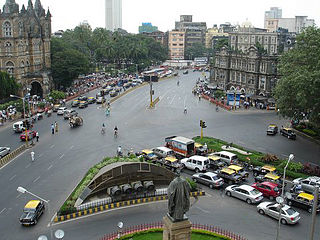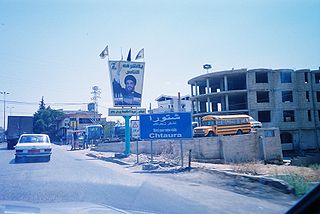
The transportation system in Mongolia consists of a network of railways, roads, waterways, and airports.
Trinidad and Tobago, a country that relies heavily on industrialisation and tourism, has various transport systems.

Public transport in Mumbai involves the transport of millions of its citizens by train, road, and water. As of 2015, 52% of commuters use public transport. Mumbai has the largest organized bus transport network among major Indian cities.

A vehicle for hire is a vehicle providing private transport or shared transport for a fee, in which passengers are generally free to choose their points or approximate points of origin and destination, unlike public transport, and which they do not drive themselves, as in car rental and carsharing. They may be offered via a ridesharing company.

A share taxi is a mode of transport which falls between a taxicab and a bus. These vehicles for hire are typically smaller than buses and usually take passengers on a fixed or semi-fixed route without timetables, but instead departing when all seats are filled. They may stop anywhere to pick up or drop off their passengers. Often found in developing countries, the vehicles used as share taxis range from four-seat cars to minibuses. They are often owner-operated.

Hong Kong taxicabs are the principal taxi service in Hong Kong. Although a few taxis are independently owned and operated, the vast majority are owned by 17 independent taxi companies that rent out taxis on a shift basis to 40,000 self-employed drivers.

Taxis of Singapore come in two main varieties. Traditional taxi companies offer flag down and call bookings and their drivers are hired employees of the company. Ridesharing companies allow bookings through a smartphone, allowing ease for passengers, these are mostly known as private hire vehicles (PHV). Their apps also allow the flexibility to work and pick up passengers with their own vehicle, be it owned or rented, provided the various requirements are met depending on the company.

A motorcycle taxi, or cart bike or bike taxi, is a licensed form of transport in some countries. The taxi typically carries one passenger, who "rides pillion" behind the motorcycle operator. Multiple passengers are common in some countries.
O.C.F.T.C is the Lebanese government authority which operates public transportation in Lebanon.

The transport system of Kolkata, a city in India, is a mix of modern mass rapid transport and old transport modalities like rickshaws. Kolkata is connected to the rest of India by the National Highways, the extensive network of the Indian Railways, National Waterways and by air. The most traffic to Northeast India route via Kolkata.
The taxicabs of the United States make up a mature system; most U.S. cities have a licensing scheme which restricts the number of taxicabs allowed. As of 2012 the total number of taxi cab drivers in the United States is 233,900; the average annual salary of a taxi cab driver is $22,820 and the expected percent job increase over the next 10 years is 16%.

The following is a list of transportation options in San Diego County, California.

Chtaura is a town in Lebanon in the fertile Beqaa valley located between the Mount Lebanon and Syria. It is located halfway on the Beirut - Damascus highway. It is located 44 kilometres (27 mi) from Beirut.

Beirut–Rafic Hariri International Airport (Arabic: مطار رفيق الحريري الدولي بيروت, is the only operational commercial airport in Lebanon, which is located in the Southern Suburbs of Beirut, Lebanon, 9 kilometres from the city center. It is the hub for Lebanon's national carrier, Middle East Airlines and was the hub for the Lebanese cargo carrier TMA cargo and Wings of Lebanon before their respective collapses.
Transport in Beirut consists of urban buses, minibuses and taxis, as well as interurban and international buses and air service.

Cars such as Toyota Etios, Maruti Omni, Mahindra Logan, Tata Indica and Tata Indigo are fairly popular among taxicab operators. The livery of the taxicabs in India varies from state to state. In Delhi and Maharashtra, most taxicabs have yellow-black livery, while in West Bengal, taxis have yellow livery. Private taxicab operators are not required to have a specific livery. However, they are required by law to be registered as commercial vehicles.

Zahlé is the capital and the largest city of Beqaa Governorate, Lebanon. With around 150,000 inhabitants, it is the third-largest city in Lebanon after Beirut and Tripoli and the fourth largest taking the whole urban area.
Public transport in Lima is handled by buses, micros, taxicabs, and the so-called mototaxis. Micros are the most common means of public transportation in Lima and many other cities in Peru. There are also more than 100 kilometres (62 mi) of cycle paths in the city.
Transportation within Cebu City is mainly land-based with most parts of the city accessible by road. There is no existing mass transit but there is an existing proposal for a Cebu Bus Rapid Transit System and Cebu Light Rail Transit System, which would solve the city's worsening traffic congestion, as existing transportation modes are currently inadequate to move residents around the city as a result of many problems and factors that the local government has failed to address.

Transport in Bangalore consists of several intracity commute modes such as BMTC buses, Namma Metro rail services, taxis and auto rickshaws, as well as several intercity forms of transport: Government operated KSRTC, NWKRTC, KKRTC, other states RTC buses, Private bus operators, trains, and flights.














